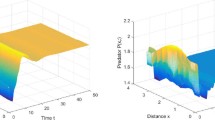Abstract
In this paper, we study a reaction-diffusion system under homogeneous Dirichlet boundary conditions that describes the evolution of population densities of a mutualist–prey species u, a predator species v and a mutualist species w. Firstly, stability properties of the trivial and semi-trivial solutions are determined completely. It is found that when the (local) stability of trivial and semi-trivial solutions change, positive stationary solutions appear and the appropriate expressions of these solutions are derived. Furthermore, we show that for large \(\gamma \), there is at most one positive stationary solution for each fixed \(b\in \mathbb {R}\), moreover it is asymptotically stable (if it exists). Our results indicate that the dynamics of the predator–prey–mutualist system is much complicated than that of the classic predator–prey system.

Similar content being viewed by others
References
Addicott, J.F.: A multispecies aphid-ant association: density dependence and species specific effects. Can. J. Zool. 57, 558–569 (1979)
Addicott, J.F.: Mutualistic interactions in population and community processes. In: A New Ecology: Navel Approaches for Interactive Systems. Wiley, New York (1983)
Blat, J., Brown, K.J.: Bifurcation of steady-state solutions in predator-prey and competition systems. Proc. R. Soc. Edinburgh Sect. A 97, 21–34 (1984)
Blat, J., Brown, K.J.: Global bifurcation of positive solutions in some systems of elliptic equations. SIAM J. Math. Anal. 17, 1339–1353 (1986)
Bently, B.L.: Extrafloral nectaries and protection by pugnacious bodyguards. Annu. Rev. Ecol. Svst. 81407–81427 (1977)
Dancer, E.N.: On the indices of fixed points of mappings in cones and applications. J. Math. Anal. Appl. 91, 131–151 (1983)
Dancer, E.N.: On positive solutions of some pairs of differential equations. Trans. Am. Math. Soc. 284, 729–743 (1984)
Dancer, E.N., Du, Y.H.: Positive solutions for a three-species competition system with diffusion. I. General existence results. Nonlinear Anal. TMA 254, 337–357 (1995)
Du, Y.H., Lou, Y.: Some uniqueness and exact multiplicity results for a predator-prey model. Trans. Am. Math. Soc. 349, 2443–2475 (1997)
Glynn, P.W.: Some physical and biological determinants of coral community structure in the eastern Pacific. Ecol. Monogr. 46, 431–456 (1976)
Guo, G.H., Wu, J.H., Nie, H.: Multiplicity for a diffusive predator-prey mutualist model. Proc. Lond. Math. Soc. 105, 342–366 (2012)
Hei, L.J.: Global bifurcation of co-existence states for a predator-prey-mutualist model with diffusion. Nonlinear Anal. Real World Appl. 8, 619–635 (2007)
López-Gómez, J.: Linear Second Order Elliptic Operators. World Scientific, Singapore (2013)
López-Gómez, J., Pardo, R.: Existence and uniqueness of coexistence states for the predator-prey model with diffusion: the scalar case. Differ. Integral Eqns 6, 1025–1031 (1993)
Pao, C.V.: On Nonlinear Parabolic and Elliptic Equations. Plenum Press, New York (1992)
Rai, B., Freedman, H.I., Addicott, J.F.: Analysis of three species models of mutualism in predator-prey and competitive systems. Math. Biosci. 65, 13–50 (1983)
Rabinowitz, P.H.: Some global results for nonlinear eigenvalue problems. J. Funct. Anal. 7, 487–513 (1971)
Shi, J.P., Wang, X.F.: On global bifurcation for quasilinear elliptic systems on bounded domains. J. Differ. Equ. 246, 2788–2812 (2009)
Yamada, Y.: Stability of steady-states for prey-predator diffusion equations with homogeneous Dirichlet conditions. SIAM J. Math. Anal. 21, 327–345 (1990)
Zheng, S.N.: A reaction-diffusion system of a predator-prey-mutualist model. Math. Biosci. 78, 217–245 (1986)
Author information
Authors and Affiliations
Corresponding author
Additional information
Publisher's Note
Springer Nature remains neutral with regard to jurisdictional claims in published maps and institutional affiliations.
Y. Dong work was partially supported by NSF of China (11801431), the Young Talent fund of University Association for Science and Technology in Shaanxi China (20190509), Postdoctoral Science Foundation of China (2018M631133) and NSF of Shaanxi Province (2021JM-445,2021JQ-657,2021JQ-662). S. Li work was partially supported by NSF of China (11901446,11971369,12071270), the Postdoctoral Science Foundation of China (2021T140530), the Young Talent fund of University Association for Science and Technology in Xi’an (095920201325) and the Fundamental Research Funds for the Central Universities (JB210705)
Rights and permissions
About this article
Cite this article
Dong, Y., Li, S. Qualitative behavior of a diffusive predator–prey–mutualist model. Z. Angew. Math. Phys. 73, 12 (2022). https://doi.org/10.1007/s00033-021-01644-1
Received:
Revised:
Accepted:
Published:
DOI: https://doi.org/10.1007/s00033-021-01644-1



